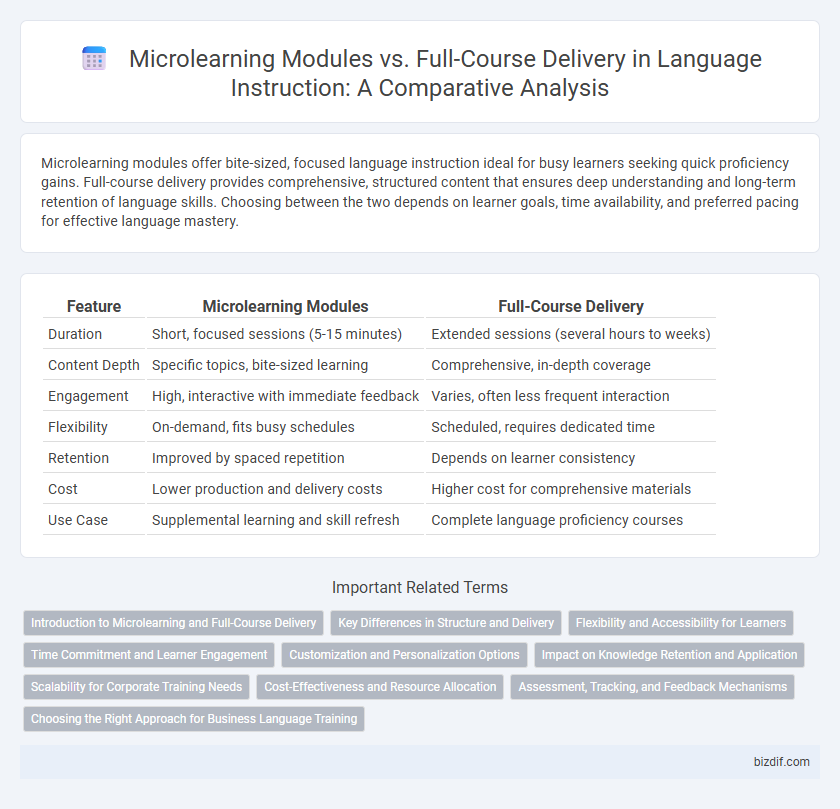Microlearning modules offer bite-sized, focused language instruction ideal for busy learners seeking quick proficiency gains. Full-course delivery provides comprehensive, structured content that ensures deep understanding and long-term retention of language skills. Choosing between the two depends on learner goals, time availability, and preferred pacing for effective language mastery.
Table of Comparison
| Feature | Microlearning Modules | Full-Course Delivery |
|---|---|---|
| Duration | Short, focused sessions (5-15 minutes) | Extended sessions (several hours to weeks) |
| Content Depth | Specific topics, bite-sized learning | Comprehensive, in-depth coverage |
| Engagement | High, interactive with immediate feedback | Varies, often less frequent interaction |
| Flexibility | On-demand, fits busy schedules | Scheduled, requires dedicated time |
| Retention | Improved by spaced repetition | Depends on learner consistency |
| Cost | Lower production and delivery costs | Higher cost for comprehensive materials |
| Use Case | Supplemental learning and skill refresh | Complete language proficiency courses |
Introduction to Microlearning and Full-Course Delivery
Microlearning modules deliver focused, bite-sized lessons designed to enhance retention and accommodate busy schedules by breaking content into manageable segments. Full-course delivery offers a comprehensive, structured curriculum that covers subject matter in-depth, ideal for learners seeking detailed knowledge and thorough understanding. Combining microlearning with full-course formats can optimize language instruction by catering to diverse learning preferences and maximized engagement.
Key Differences in Structure and Delivery
Microlearning modules deliver content in focused, brief segments typically lasting 5 to 10 minutes, enhancing retention through targeted, interactive activities. Full-course delivery encompasses comprehensive, structured lessons over several hours or days, facilitating in-depth exploration of language concepts with extensive practice opportunities. Microlearning supports flexible, on-the-go learning, while full courses provide systematic progression and holistic language acquisition.
Flexibility and Accessibility for Learners
Microlearning modules enhance flexibility by delivering bite-sized lessons accessible anytime on multiple devices, accommodating diverse schedules and learning paces. Full-course delivery offers comprehensive content but often requires fixed time commitments, limiting immediate accessibility for busy learners. Prioritizing microlearning supports continuous engagement and adapts to varied learner environments, maximizing accessibility and retention.
Time Commitment and Learner Engagement
Microlearning modules require significantly less time commitment, typically ranging from 5 to 15 minutes per session, making them ideal for learners with busy schedules. These short, focused lessons enhance learner engagement by targeting specific skills and allowing for instant application and frequent reinforcement. In contrast, full-course delivery demands several hours of continuous learning, which can lead to decreased attention spans and higher dropout rates.
Customization and Personalization Options
Microlearning modules offer greater customization by allowing learners to select specific topics tailored to their individual needs, promoting personalized pacing and focused content absorption. Full-course delivery typically follows a fixed curriculum, limiting flexibility but providing a comprehensive, structured learning experience. Customization options in microlearning enhance engagement and knowledge retention by adapting to diverse learning styles and immediate skill requirements.
Impact on Knowledge Retention and Application
Microlearning modules, characterized by concise and targeted content, enhance knowledge retention by breaking down complex language concepts into manageable segments that learners can absorb quickly. Full-course delivery provides comprehensive coverage but may overwhelm learners, leading to decreased long-term retention and slower application of language skills. Empirical studies show that microlearning's focused approach accelerates practical language use and adaptability in real-world communication scenarios.
Scalability for Corporate Training Needs
Microlearning modules offer unparalleled scalability by delivering concise, targeted content that can be rapidly deployed across diverse teams and locations, optimizing learner engagement and retention in corporate training. Full-course delivery, while comprehensive, often requires significant resources and time, limiting its adaptability to fast-evolving business needs and large-scale implementation. Prioritizing microlearning enables organizations to efficiently scale training initiatives, reduce costs, and maintain consistent skill development amidst dynamic workplace demands.
Cost-Effectiveness and Resource Allocation
Microlearning modules reduce training costs by delivering targeted language instruction in short, focused segments that minimize development and update expenses compared to full-course delivery. Resource allocation benefits from microlearning's flexible deployment, allowing organizations to efficiently assign time and personnel without disrupting workflow. This approach optimizes budget expenditure while maintaining language proficiency outcomes through incremental skill acquisition.
Assessment, Tracking, and Feedback Mechanisms
Microlearning modules offer frequent, targeted assessments that enhance real-time tracking of learner progress, enabling prompt, personalized feedback to reinforce language retention. In contrast, full-course delivery typically employs comprehensive periodic assessments, which may delay feedback and hinder immediate correction of language errors. Integrating advanced tracking tools within microlearning platforms optimizes learner engagement and adaptive feedback, crucial for effective language instruction outcomes.
Choosing the Right Approach for Business Language Training
Microlearning modules offer targeted, bite-sized lessons that enhance retention and fit seamlessly into busy work schedules, making them ideal for businesses seeking flexible language training. Full-course delivery provides comprehensive, structured learning pathways that build foundational skills and support long-term language proficiency development. Selecting the right approach depends on organizational goals, employee time availability, and the desired depth of language mastery for business communication.
Microlearning Modules vs Full-Course Delivery Infographic

 bizdif.com
bizdif.com